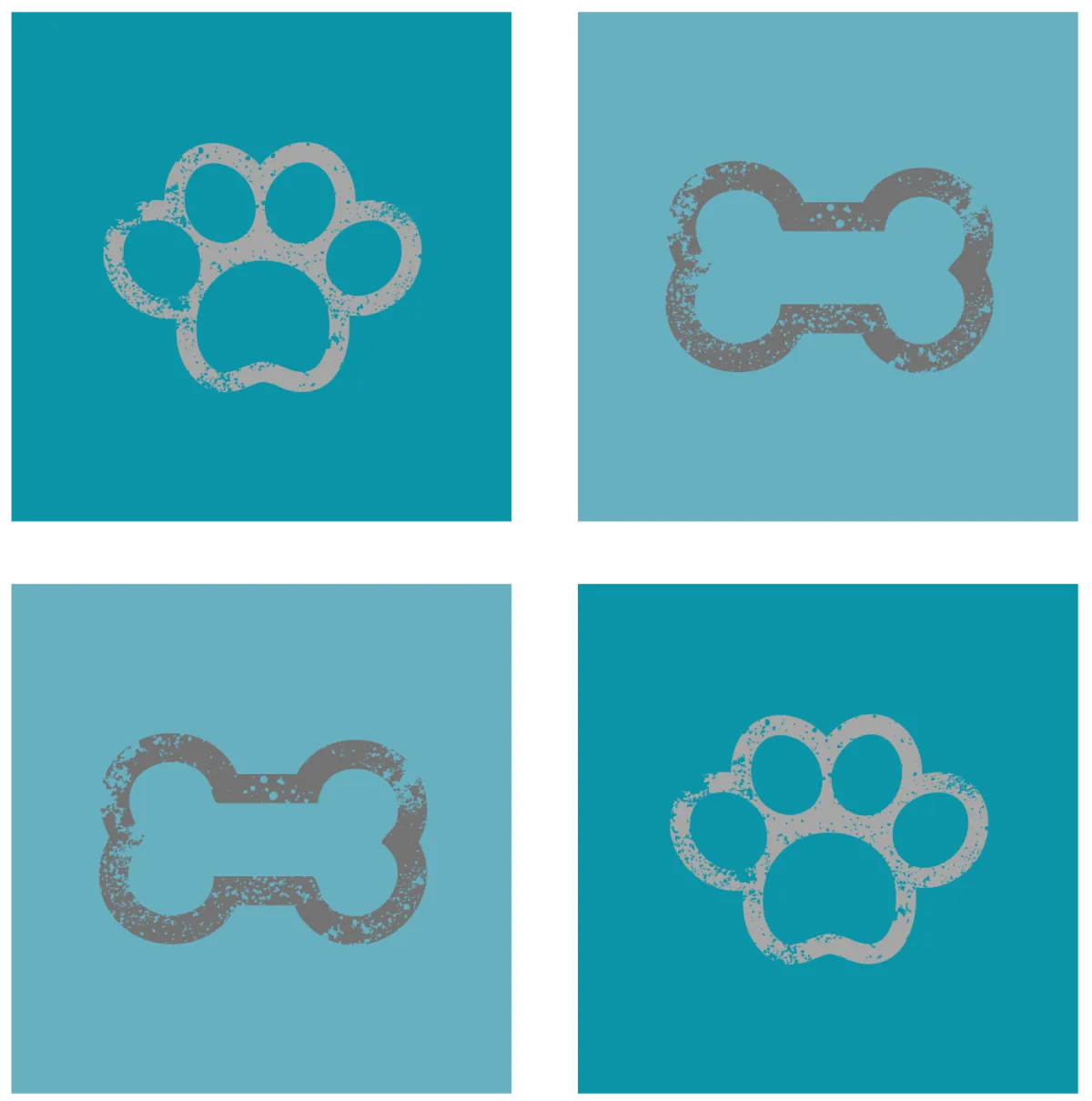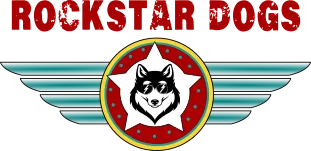WINDOW THEORY

Window Theory is a way of being more intentional as you go about your day with your dog. It gives you another way to teach acceptable behaviors in any given situation without having to put as much time and effort into strict obedience work. Taking care to incorporate all 4 windows into each day will build good habits and discipline for you and your dog, ensuring they have an outlet for their mental and physical energies, balanced by adequate rest and free time between activities. Make a commitment to spending time in all four windows for a more fulfilling life with your dog.
LIBERTY
(Innate)
STRUCTURED
(Conditioned)
Free Play
In the Free Play window, dogs are free to do as they wish-make their own fun. Go get the zoomies, chase a squirrel, romp and play off leash. They're free to play or relax, as they choose. They should stay aware and connected to you, but entertain themselves.
Structured Play
Structured Play is for fun and games, but unlike the Free Play window, Structured Play is for interactive play together. This window is like a sport, the games have rules. Structured Play has a beginning, chosen by you, an end, and clear rules and boundaries.
Chill Out
The Chill Out window is free time for the dog. It's a time for relaxation and calm. For some dogs this window may be is very brief, especially in the beginning, but they all have their moments. With training they can learn to relax more readily.
Work
During the Work window, we're interacting with our dogs in formal training exercises and structured activities like walks, competing in sports or any purposeful work the dog is trained in, such as a service dog.
Liberty Windows - Innate To the Dog
The Free Play and Chill Out windows come naturally to most dogs. They're an expression of instincts and drives that are innate to the dog. To be physically, mentally and emotionally healthy your dog needs these windows. These windows take place when the dog is at liberty-not under your direct control.
Structured Windows - Conditioned by Us
The Structured Play and Work windows are a result of what you have taught your dog. They involve building on your dog's instinct to cooperate and work with you. In these windows you'll be actively interacting with your dog while teaching them skills and building their character and emotional impulse control. In these windows your dog is operating under the direction of you, the handler. The goal is to develop a conditioned response that will help you direct your dog as needed.
In order to be effective, all of the windows need to be conditioned and paired with a cue, so that your dog can slip fluidly into the behaviors associated with that window on command.
How Does It Work?
There are two primary ways we can use window theory to our mutual benefit.
Developing a training plan. Window Theory can be used to diagnose as well as treat behavior issues.
Provides a context for your dog to understand “what time is it?”. Conditioned properly your dog can learn to shift their behavior quickly and easily, matching their behavior to the situation.
Develop a Training Plan
Ideally, dogs should routinely spend their time in all four windows and be able to shift fluidly between them when needed. Being conscious of the windows gives you a benchmark for evaluating yourself as a dog owner, ensuring that you are fulfilling your dog's most basic needs, proactively. When a dog is "stuck", existing primarily in one or two of the windows we will inevitably see some behavior issues. BALANCE is where it's at.
An average dog will naturally spend time in the Liberty (innate) windows, Free Play and Chill Out. The Structured Play window also comes naturally for dogs who have a strong social connection with you. The Work window is a human invention, something we do to help us influence the dogs behavior. In both of the Structured windows we teach them to do things that are not natural for them, but they're happy to do what we ask if we build a history of reinforcement for it. Together each window works with the others, resulting in a happy and well balanced dog, emotionally and physically.
Does your dog spend it's time primarily in the Free Play window, but very little time in the Calm window? Many if not all dogs who practice problematic behaviors typically spend way too much time in the Free Play window and not enough in the Chill Out window or the Work and Structured Play windows.
The Free Play window represents a dog that is free to do as they like, but that doesn't always manifest in play. Many of these dogs are lacking in confidence and suffer from a lack of guidance. They may not be playful by nature, but neither are they calm. These dogs can be very fearful, anxious, prone to mild or even moderate aggression and anti social. For them, finding their own fun may look more like hiding out and/or being defensive. The structured play and work windows as well as the chill out window helps them learn to self-regulate and enjoy being a dog again.
Dogs who want to play, play. play and are unable to chill out are at best annoying and hyperactive. It can also create anxiety, fearfulness, or defensiveness, due to the well-intentioned but ineffective efforts of people to control them. These dogs are susceptible to emotional triggers and can be very reactive or even aggressive.
Another negative aspect of too much free play is a dog who is bored. It's counter-intuitive, but many dogs don't do really great when left to their own devices for entertainment. A dog's idea of "find your own fun" can lead to a dog who engages in all kinds of mischief if they don't have enough of the other three windows.
Dogs who lack the desire to engage in playful interactions with us need to be encouraged over time, as we build that relationship with them. Together each window works with the others, resulting in a happy and well balanced dog, emotionally and physically.
Each dog is different and has different needs. Once you teach your dog what each window means and how to go into it on cue, you have the ability to give your dog exactly the balance they need to thrive.
What Time Is it?
Once you have taught and conditioned your dog to understand window theory and they know the cues, you'll have an easy and reliable mechanism for telling your dog to change not just their behavior, but also their mindset. It's like telling a child to use their indoor voice, or no rough housing in the house. Your dog will know immediately what you mean and how they should respond. In the process of conditioning the windows a Conditioned Emotional Response (CER) is built in, so that they will happily make the shift mentally, which results in the shift physically.
Sound difficult? Not So! That's the beauty of window theory. All it take is for you to be aware, be consistent, and be good at building a history of reinforcement for each window. Then, if your dog is behaving in a way that you don't want right then, you just tell them, "it's not time for that window, it's time for this window."
How Do We Do It?
The process of teaching window theory to your dog isn't complicated. It goes like this:
Identify what activities are included in each window. Each dog and home is different, you need to decide for yourself what is allowed in each window.
Select a Trigger Cue that will let your dog know which window is open now.
Deliberately work each window into your daily routine and use the cue to help your dog understand what it means.
Consistently practice and reinforce the activities in each window.
Trigger Cues
Here are suggestions for cues that you can use to tell your dog it's time for a specific window.
Free Play - "Free!" "Go Play!" " Break!"
Chill Out - "All Done" "Enough" "Chill Out"
Structured Play - "Ready?"
Work - Generally I use the dog's name followed by going right into an obedience command. Often "Come" or "Let's Go!" is the first command.
Moderator Cues
Moderator cues aren't intended to trigger a window so much as to add additional instructions for the dog in that moment while they remain in the window. These cues can be used to soften within a window or to direct a temporary transition from one window to the next.
Easy
I often use "Easy" in the Chill Out window as I condition the general understanding of that window. But it is an actual behavior, something that needs to be taught specifically, similar to teaching a cut off cue like "Leave It" or "Out". They won't understand it as organically as they understand other activities in the Chill Out window.
The Chill Out window is meant to be an "At Liberty" window, but sometimes we need to have the dog under restraint when we are handling them for medical or grooming purposes, or when we are teaching impulse control exercises. Technically, the dog isn't at liberty at such times. However, once the dog understands the word "Easy", what it means, how to respond, and we have built a Conditioned Emotional Response (CER) to the word, the dog will then be able to be at liberty, but will simply calm down.
I often use "Easy" in the Free Play window if the dog is getting a little too rambunctious for safety, especially when playing with other dogs. It's very nice to see them immediately ease up on their play so that there isn't a need to call them out of the Free Play window, they can simply dial it back a little and carry on.
Out
"Out" is an actual obedience command, so using it can trigger a shift from one window into the Work window, or it can be part of the Structured Play window. "Out!" is a strong command that, depending on what is happening at the moment, tells the dog to do one of two things:
If they have something in their mouth, they must spit it out and move away from it. That last part is key. Typically this is how we ask them to drop a ball or toy.
It also doubles as a general cut off cue that tells the dog to STOP what they are doing. Barking like mad, lunging on leash, fence fighting, resource guarding...all of these are situations where your can use "Out". Used as a cut off cue it should always be followed by a redirection cue, most commonly "Come". Then you can direct the dog however you like from there.
ADDRESS
15383 SE 22nd Pl
CALL or TEXT
(425) 475-1781
HOURS
Monday-Saturday
By Appointment only
SERVING
Greater Seattle Metro Area
Bellevue
Issaquah
Mercer Island
Kirkland
Redmond
Renton
Newcastle
FROM PUPPIES TO ADULT DOGS
- Obedience
- Good Manners
- Off Leash Training
- Behavior Modification
- Fear and Anxiety
- Reactivity and Aggression
- Destructive Behavior
- Boundary Training

